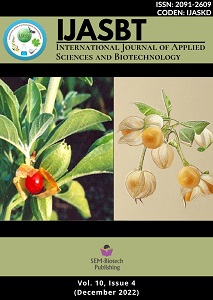Epidemiology of Camel Brucellosis Intended for Export from Kassala State – Eastern Sudan
DOI:
https://doi.org/10.3126/ijasbt.v10i4.48495Keywords:
brucellosis ., Kassla ..Camels ElisaAbstract
Summary
This study was designed to determine the seroprevalence rate of Brucellosis and to identify the risk factors for Brucella infection in camels intended for export from Kassala State. A total of 400 blood samples were collected for serum from all Kassala localities, tested using Rose Bengal Plate test (RBPT) and Competitive Enzyme Linked Immunosorbent Assay C.ELISA). The prevalence rate was (29.5 %) and (27.8%) based on the results of RBPT and C.ELISA respectively. According to sex, the prevalence rate of the disease was (30.4%) out of 335 in males and (24.6%) out of 65 in females. There were no clinical signs of camel's Brucellosis in all tested animals. The prevalence of the disease was (14.4%) in Rural KhashmElgerba, (15.3%) in North Delta, (8.5%) in Wad Elhilau, Rural Kassala (11.9%), Hamashkoreb (12.7%), Rustic Arouma (14.4%), Talkook (16.9%) and Atbra river locality (5.9%) with a significant statistical difference. Herds with more than 20 camels were more frequently affected. In this study the Seroprevalence of Brucella was (9.3 %) in young (1-2 years) and (23.7%) in adult camels (above 5 years). The results of the present study provide the status of seropositivity to Brucella in camels intended for export in Kassala State and the risk factors that contribute to prevalence of Brucellosis among camels. This situation requires more attention and effort to implement.
Int. J. Appl. Sci. Biotechnol. Vol 10(4): 216-220.
Downloads
Downloads
Published
How to Cite
Issue
Section
License
Copyright (c) 2022 International Journal of Applied Sciences and Biotechnology

This work is licensed under a Creative Commons Attribution-NonCommercial 4.0 International License.




